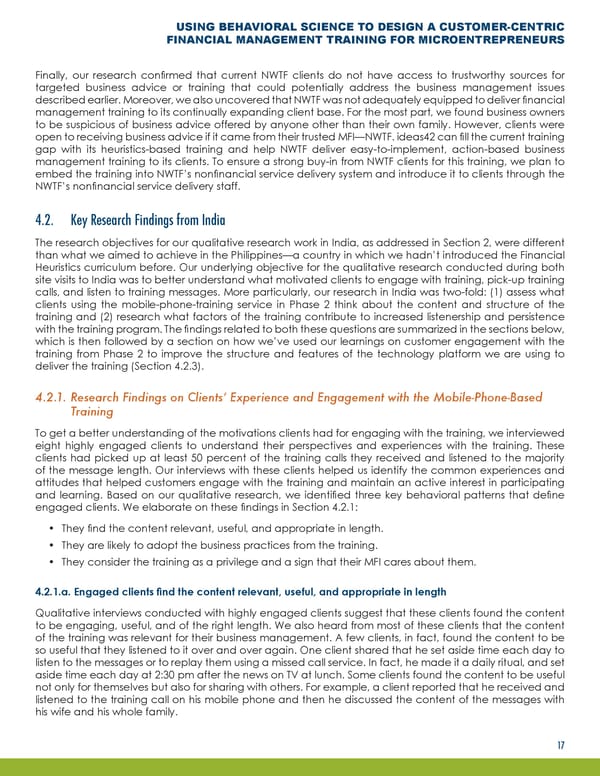USING BEHAVIORAL SCIENCE TO DESIGN A CUSTOMER-CENTRIC FINANCIAL MANAGEMENT TRAINING FOR MICROENTREPRENEURS Finally, our research confirmed that current NWTF clients do not have access to trustworthy sources for targeted business advice or training that could potentially address the business management issues described earlier. Moreover, we also uncovered that NWTF was not adequately equipped to deliver financial management training to its continually expanding client base. For the most part, we found business owners to be suspicious of business advice offered by anyone other than their own family. However, clients were open to receiving business advice if it came from their trusted MFI—NWTF. ideas42 can fill the current training gap with its heuristics-based training and help NWTF deliver easy-to-implement, action-based business management training to its clients. To ensure a strong buy-in from NWTF clients for this training, we plan to embed the training into NWTF’s nonfinancial service delivery system and introduce it to clients through the NWTF’s nonfinancial service delivery staff. 4.2. Key Research Findings from India The research objectives for our qualitative research work in India, as addressed in Section 2, were different than what we aimed to achieve in the Philippines—a country in which we hadn’t introduced the Financial Heuristics curriculum before. Our underlying objective for the qualitative research conducted during both site visits to India was to better understand what motivated clients to engage with training, pick-up training calls, and listen to training messages. More particularly, our research in India was two-fold: (1) assess what clients using the mobile-phone-training service in Phase 2 think about the content and structure of the training and (2) research what factors of the training contribute to increased listenership and persistence with the training program. The findings related to both these questions are summarized in the sections below, which is then followed by a section on how we’ve used our learnings on customer engagement with the training from Phase 2 to improve the structure and features of the technology platform we are using to deliver the training (Section 4.2.3). 4.2.1. Research Findings on Clients’ Experience and Engagement with the Mobile-Phone-Based Training To get a better understanding of the motivations clients had for engaging with the training, we interviewed eight highly engaged clients to understand their perspectives and experiences with the training. These clients had picked up at least 50 percent of the training calls they received and listened to the majority of the message length. Our interviews with these clients helped us identify the common experiences and attitudes that helped customers engage with the training and maintain an active interest in participating and learning. Based on our qualitative research, we identified three key behavioral patterns that define engaged clients. We elaborate on these findings in Section 4.2.1: • They find the content relevant, useful, and appropriate in length. • They are likely to adopt the business practices from the training. • They consider the training as a privilege and a sign that their MFI cares about them. 4.2.1.a. Engaged clients find the content relevant, useful, and appropriate in length Qualitative interviews conducted with highly engaged clients suggest that these clients found the content to be engaging, useful, and of the right length. We also heard from most of these clients that the content of the training was relevant for their business management. A few clients, in fact, found the content to be so useful that they listened to it over and over again. One client shared that he set aside time each day to listen to the messages or to replay them using a missed call service. In fact, he made it a daily ritual, and set day at 2:30 pm after the news on TV at lunch. Some clients found the content to be useful aside time each not only for themselves but also for sharing with others. For example, a client reported that he received and listened to the training call on his mobile phone and then he discussed the content of the messages with his wife and his whole family. 17
 Using Behavioral Science to Design a Customer-Centric Financial Management Training for Microentrepreneurs Page 19 Page 21
Using Behavioral Science to Design a Customer-Centric Financial Management Training for Microentrepreneurs Page 19 Page 21